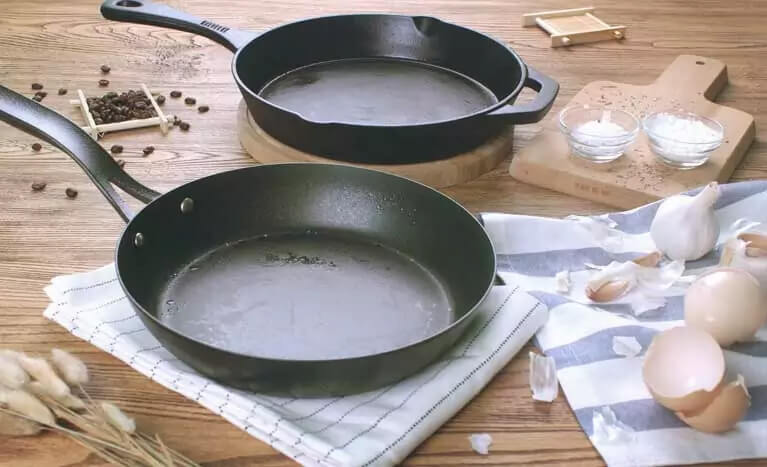Strap in because we’re about to transport back in time. Join me in my journey to the roots of a more natural lifestyle.
Do you cook with cast iron? The idea of cast iron coincides with camping or covered wagons transporting Americans across the plains centuries ago (at least those ideas play out in my mind.) I recently traveled back in time to my great-grandparents homestead by purchasing my very first cast iron pan, and I’ve fallen in love with homestead-style cooking. My grandma swore by cast iron cookware, but I never thought to try it out until now. Even without it, I still feel a connection to my family roots every time I cook with cast iron! I don’t have a fire pit in my backyard yet, like my forebears had, but my new Lodge cast iron pan performs perfectly in my modern oven.
I recently became fascinated by cast iron. Modern day cookware, specifically non-stick cookware, has riddled headlines with its potential links to cancer. A plethora of information is available, but most people overlook this potential poison because it’s so widely used in kitchens, and cancer seems far-fetched. Honestly, who the heck knows what goes into our cookware. I do know that a carcinogenic chemical named “perfluorooctanoic acid” is used to coat non-stick pans, and it leaches into food at high temperatures and fills the air with toxic fumes—YIKES! The coating of my non-stick cookware eventually always peels off—so it had to be peppering my food. Hopefully I didn’t damage to my body unknowingly by consuming bits of non-stick surfaces. With cast iron, I won’t worry about weird chemicals. Some iron may leach into my food, but iron can be beneficial to health—can’t say the same for perfluorooctanoic acid.
When I think of homestead cooking, I get visions of all-natural food preparation: fuel from the forest, flickering flames, all organic ingredients. No modern-day conveniences of electric ovens or weird beeps and noises in the kitchen. I picture a wood stove tucked in the corner of house or a fire pit in the yard. I know that my great-grandparents grew most of what they needed on the homestead. I visualize them cooking garden-fresh food over a fire in their cast irons. I don’t see non-stick cookware strewn about the cabin. I want to live that more natural way of life, and I plan to bring it back one step at a time. I started last week by purchasing a Lodge 12-inch cast iron pan and a cast iron Dutch oven. I will discuss my cast iron pan because I haven’t used my Dutch oven yet.
Using cast iron cookware is like cooking with magic. I prepare dishes on the stovetop in the cast iron, and then transfer it directly to the oven—no need to mix food in bowls and transfer it to an oven safe container! This brings an added level of convenience to cooking, and lots less dishes!
The four items I’ve cooked in my cast iron pan so far: sourdough English muffins, cast iron nachos, skillet cheese broccoli gnocchi, and a vegetable pot pie. I also eliminated messy cleanups riddled with multiple cooking dishes. You may think dishes like vegetarian pot pie would create a mess in a cast iron pan, but cast iron is so easy to clean that it even surprised me!
How to Season a Cast Iron Pan
At first, cooking with cast iron seemed daunting because I imagined they were extremely high maintenance. That’s not the case. They do require special care, but nothing too difficult. Cast iron cookware must be “seasoned” and cannot sit in water like other cookware. Water will cause cast iron to rust, and you don’t want that! Seasoning your cast iron helps create a non-stick surface, which cast iron is known for. So far, I haven’t had anything stick to my pan. If you purchase a pre-seasoned pan, you should still season it before use. Seasoning is easy.
Follow these steps to season your cast iron pan:
- Preheat your oven to 400F
- Lightly coat the bottom, sides, top, handle, and every part of the cast iron with avocado oil (many different healthy oils can be used, so research what is best for you)
- Wipe off the excess oil with a tea cloth
- Place the cast iron on an oven rack upside down, so any excess oil doesn’t pool
- Repeat this process 3 to 4 times before cooking on it for the first time
By seasoning your cast iron, you build up the non-stick surface with oil instead of toxic chemicals. It’s easy!
Another magical element of cast iron is that it can be passed down through generations—they can last indefinitely if properly cared for. If I had known this a while ago, I would have asked my grandma to pass me her cast iron cookware. I plan to properly care for my pans and Dutch oven, so one day I can pass these items to my children.
I hope you consider this time-tested method of cooking for you and your family and return with me on my journey to the roots of a more natural lifestyle.

